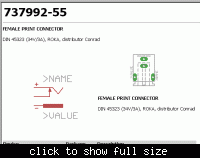zia.newversion
Member level 5

Ok. I am not asking for a PCB footprint for a DC Power Jack since I have searched and seen a few members getting scolded over asking a stupid question which could easily be solved by searching. I already have a PCB footprint of a DC Power Jack. I am using EagleCAD and the schematic is confusing me, partly because I have never used a DC Power Jack before (Yeah, we have a power supply which has croc clips at the power terminals  )
)
Anyway, the picture of the schematic is attached... Can anyone please explain how a DC power jack works? And where normal power supplies have two terminals, why does it have four? And how would I use this schematic? How can I find out which terminal is V+, which one is V- or GND... Please help. Thank you.
P.S. If anyone is wondering, the schematic AND the footprint came from Sparkfun Library for Eagle.
Anyway, the picture of the schematic is attached... Can anyone please explain how a DC power jack works? And where normal power supplies have two terminals, why does it have four? And how would I use this schematic? How can I find out which terminal is V+, which one is V- or GND... Please help. Thank you.
P.S. If anyone is wondering, the schematic AND the footprint came from Sparkfun Library for Eagle.


